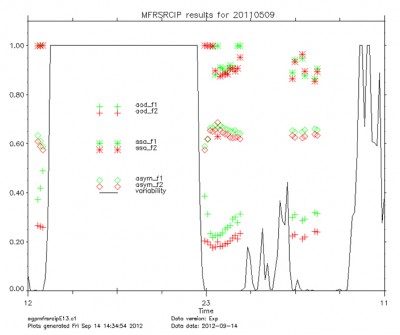New Evaluation Product Estimates Aerosol Properties
Published: 9 October 2012

The MFRSR-Column Intensive Properties (MFRSRCIP) value-added product (VAP) has been developed for estimating the microphysical (e.g., size distribution) and optical (e.g., single-scattering albedo and asymmetry factor) properties of aerosols. Size distribution retrieval is based on multifilter rotating shadowband radiometer (MFRSR) measurements of the direct irradiance at five wavelengths (415, 500, 615, 673, and 870 nm) and assumptions regarding the shape of the aerosol size distribution (a combination of two lognormal distributions) and the refractive index. Optical properties retrieval is based on the retrieved size distribution, assumed real refractive index, measured direct and diffuse irradiances, and an estimate of the spectral values of surface albedo.
To reduce the potential impact of surface albedo uncertainties on the retrieved optical properties, the current version of the VAP uses direct and diffuse irradiances at two wavelengths (415 and 500 nm). The assumption regarding the real refractive index is based on available independent measurements. MFRSRCIP evaluation data are available for the ARM Southern Great Plains (SGP) site for the period January 1 to December 31, 2011.
More information on MFRSRCIP is available at the VAP web page and in the README file that accompanies the data files in the ARM Data Archive’s evaluation area. Please send any comments and suggestions related to the product to Annette Koontz. Feedback will assist in improving the product prior to its full release.
To access these data, log in to the Data Archive. (Go here to request an account.)
The ARM Climate Research Facility is a DOE Office of Science user facility. The ARM Facility is operated by nine DOE national laboratories, including .
Keep up with the Atmospheric Observer
Updates on ARM news, events, and opportunities delivered to your inbox
ARM User Profile
ARM welcomes users from all institutions and nations. A free ARM user account is needed to access ARM data.


















